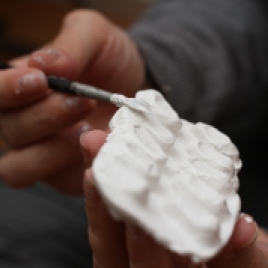“The Art of Memory” arrived unscathed throughout the yesterday transportation home… Reading last night in the exhibition guest book i strongly need to express my gratitude and joy to every one who made it to the exhibition – especially during that freak flood mayhem in the city! Thank you for your words, thank you for being there and making the night into such a wonderful moment!! ![]() 💖
💖
The Art of Memory archive started roughly 10 years ago, as a necessity to record “evidences” of a new experience that was just unfolding – the “self-imposed exile” as i used to call it, in an unknown country, isolated from familiar environment and native language and being delivered to puzzling challenges where the every day justification and questioning of my identity was probably the most painful of them.
This archive turned slowly into an artistic practice and became the research incentive for my Master degree, L´intime à l´oeuvre. La peau des 100 odeurs. The theoretic work studies the autobiographic works – foremost those in the field of fine arts and the implications of turning one´s intimate space into a work medium. The last chapter, “La peau des 100 odeurs. 100 odeurs de l´intime” (“The Skin of 100 Scents. 100 Inner Scents”) decomposes the experiences of a “self-imposed exile” from the sensorial perspective. There are certain scents, smells, flavours, fragrances and odors that are playing a critical role in the building (or rebuilding when it had been lost) of identifiable (communication) structures.
These scents are organized in the chapter into an “olfactory atlas”, according to the earliest memories of childhood and classified into ten color-coded categories: Green/The Sap (vert – les sèves); Reds (les rouges – les terres); Translucents (les translucides); Heavy Whites (les blancs riches); Grey/Smoke (les fumés); Gold (l´or); Pinks (les roses); Blue (le bleu); Placenta (placenta); Penicillin (pénicilline).
I started this week to build actual capsules for each of the described scent using the depicted materials. I started with the last category the “Penicillin” which is described as it follows:
The last category is the Penicillin. The smell of anxiety, phobia and the fear of disintegration of the flesh. The smell of penicillin is under the sign of inorganic decay, of isolation, of miserable helplessness, like the taste of exile in its dire light. In this category belong the smells and scents that are linked to the primary safety needs. As a child, the nec plus ultra of fear was represented by the stench of antibiotic that i use to take in large quantities over long periods of time. In this category belong as well, the smell of hospital disinfectant, of fresh cast and of concrete – a material which marked a demolishing political regime prone to dismantle a society of its individual traits.
(© Transl. from French, Luiza Mogosanu, L´intime à l´oeuvre. La peau des 100 odeurs, PAF, 2013)















This is fascinating, your whole premise. And I loved seeing the transformation process into art.
LikeLiked by 1 person
Thank you so much!! ❤
LikeLiked by 1 person
Well done!
LikeLiked by 1 person
Thanks a lot!! 🖖
LikeLiked by 1 person
I would not have associated penicillin with a smell, but you must have required repeated treatments, and developed an aversion to the experience. Our olfactory brain has a powerful memory.
LikeLiked by 1 person
Yes, this is totally the case. I could never unlearn the stabbing taste of those pills and the pain of the numerous shots. Well, the mood within the ´iron curtain´ in the ´80 was rather bitter too…
LikeLiked by 1 person